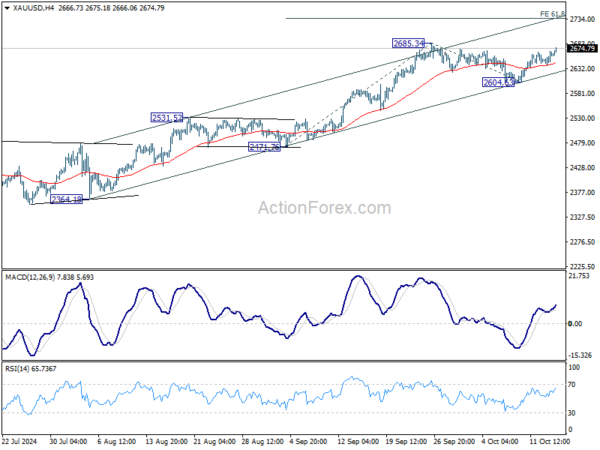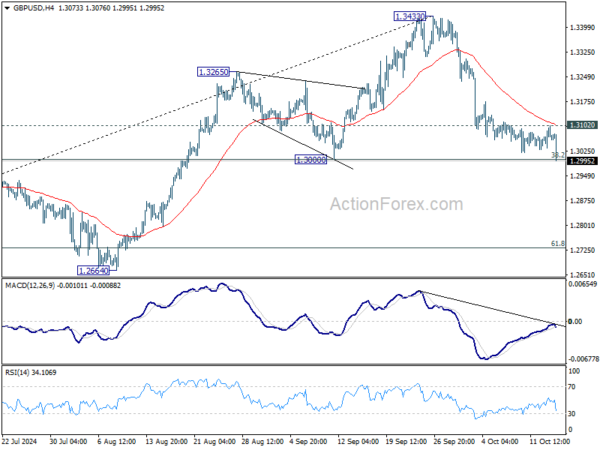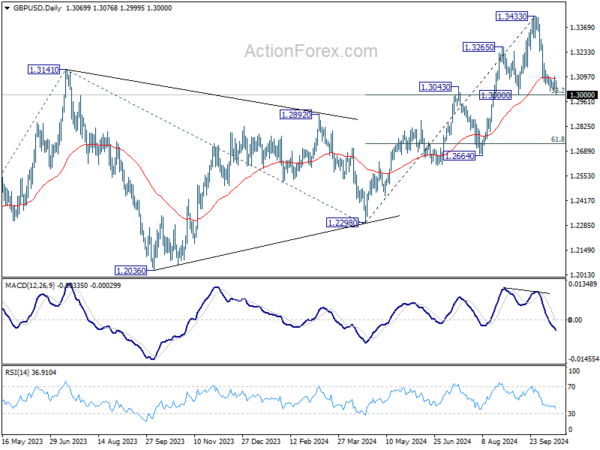Sterling has taken a significant hit after UK inflation data for September showed sharper-than-expected decline, falling below BoE’s 2% target again, and hit the lowest level in over three years. Core CPI also fell more than forecasted, indicating a stronger pace of disinflation. Services prices, a key inflation driver, showed a marked slowdown, reinforcing the view that inflationary pressures in the UK are easing at a quicker pace than anticipated.
This latest data bolsters the case for BoE to resume monetary easing, with market expectations now favoring a 25bps rate cut at the next meeting on November 8. The clear signs of weakening inflation give BoE room to act more decisively in its removing monetary restrictions to support growth.
Meanwhile, the New Zealand Dollar also faced downward pressure following data that confirmed a sharp decline in inflation during Q3, reaching its lowest level since early 2021. This data supports RBNZ’s earlier 50bps rate cut, and reinforces expectations that another large cut could follow on November 27. RBNZ’s aggressive stance is likely to continue as inflation in New Zealand continues to cool more quickly than it expected.
In the broader currency market, Australian Dollar is currently the weakest performer, struggling under the weight of uncertainties surrounding China’s fiscal stimulus. New Zealand Dollar follows close behind, while Swiss Franc is under pressure as well. On the other side, Dollar is strengthening, supported by comments from Fed officials that they foresee two, or even just one, more rate cuts this year. Canadian Dollar and Japanese Yen are also holding slightly stronger positions,. Euro and Sterling are in the middle of the pack. However, Sterling could see further declines if market sentiment continues to sour.
Technically, Gold’s extended bounce from 2604.63 suggests that correction from 2685.32 has completed after drawing support from the near term rising channel. Firm break of 2685.34 would target 61.8% projection of 2471.76 to 2685.34 from 2604.63 at 2736.32. However, this time, Gold’s rally might occur in tandem with Euro weakness, rather than a decline in the US Dollar.
In Asia, Nikkei fell -1.83%. Hong Kong HSI is flat. China Shanghai SSE is down -0.24%. Singapore Strait Times is up 0.33%. Japan 10-year JGB yield fell -0.0151 to 0.961. Overnight, DOW fell -0.75%. S&P 500 fell -0.76%. NASDAQ fell -1.01%. 10-year yield fell -0.060 to 4.038.
UK CPI falls to 1.7% in Sep, core CPI down to 3.2%
UK CPI slowed more than expected from 2.2% yoy to 1.7% yoy in September, below expectation of 1.9% yoy.Core CPI (excluding energy, food, alcohol and tobacco) slowed from 3.6% yoy to 3.2% yoy, below expectation of 3.4% yoy. CPI goods fell from -0.9% yoy to -1.4% yoy. CPI services also slowed from 5.6% yoy to 4.9% yoy.
ONS Chief Economist Grant Fitzner said: “Inflation eased in September to its lowest annual rate in over three years. Lower airfares and petrol prices were the biggest driver for this month’s fall. These were partially offset by increases for food and non-alcoholic drinks, the first time that food price inflation has strengthened since early last year. “Meanwhile the cost of raw materials for businesses fell again, driven by lower crude oil prices.”
NZ CPI falls to 2.2% in Q3, back in RBNZ’s target band
New Zealand’s CPI rose 0.6% qoq in Q3, slightly below market expectations of 0.7% qoq. Annually, inflation slowed sharply from 3.3% yoy to 2.2% yoy, in line with forecasts.
This marks the first time since March 2021 that annual inflation has returned within RBNZ’s target range of 1 to 3%. The result was also softer than RBNZ’s own forecast of 0.8% quarterly and 2.3% annual inflation.
Rent prices were the largest contributor to the annual inflation figure, rising by 4.5%. Nearly 20% of the overall inflation increase came from rent.
On the other hand, lower fuel costs, with petrol prices dropping -8.0%, helped balance rising costs, alongside a notable -17.9% drop in vegetable prices following last year’s spike in potato, kūmara, and onion prices.
RBA’s Hunter: Monitoring China’s stimulus and inflation expectations closely
RBA Assistant Governor Sarah Hunter emphasized today the importance of China’s economic stimulus measures for Australia, noting that the central bank is actively assessing their local implications.
In a Bloomberg interview, Hunter explained, “We are factoring it into our forecasts going into November,” as China remains a key player in Australia’s economy. “China’s still very important, and we put a lot of our time and attention into thinking through what’s happening there and what it means for the economy here.”
In a separate speech, Hunter also addressed the importance of keeping inflation expectations anchored within RBA’s 2-3% target range.
She noted that “the fact that expectations feed into actual inflation outcomes means de-anchored expectations typically lead to greater inflation volatility.”
RBA remains vigilant to ensure inflation expectations remain steady, as de-anchoring could cause significant economic disruption. Hunter stressed the need to constantly track and understand how inflation expectations are evolving to mitigate any risks to the broader economy.
Australia’s Westpac leading index ticks up to -0.15%, growth outlook remains subdued
Australia’s Westpac Leading Index showed a slight improvement, rising from -0.26% to -0.15% in September. However, the index remains in negative territory, indicating “below-trend momentum” that is expected to carry into 2025.
Westpac maintains that while growth will improve next year, it will remain “relatively subdued,” with GDP growth forecasted to gradually rise from annualized 1% currently to 1.5% by the end of 2024, reaching 2.4% by the end of 2025—still below the long-term trend of slightly above 2.5%.
As for monetary policy, RBA is not expected to change its cash rate target at the upcoming meetings in November and December.
However, Westpac anticipates a shift in RBA’s messages, moving away from its 2024 focus on “inflation vigilance.”
Key data releases, including Q3 CPI on October 30 and national accounts on December 4, are likely to confirm a subdued growth environment and provide RBA with enough confidence to start considering less restrictive policies in 2025.
BoJ’s Adachi warns against premature rate hikes, urges most conservative approach
In a speech today, BoJ Board Member Seiji Adachi suggested that Japan’s economy has met the conditions for beginning to normalize its ultra-loose monetary policy. He pointed to the firm economic outlook and broadening price increases as positive signs.
However, Adachi emphasized the need for caution, stating that until underlying inflation sustainably reaches the 2% target, Japan must maintain an “accommodative” financial environment. He added that any interest rate increases should be at a “very moderate pace.”
Adachi also stressed the importance to “avoid raising rates prematurely”, suggesting that BoJ should use the “most conservative estimate” when considering policy adjustments.
“Given high uncertainty surrounding global developments, there is significant uncertainty over next year’s wage developments in Japan. We must carefully monitor the situation,” Adachi added.
Fed’s Daly: One or two more rate cuts reasonable this year
San Francisco Fed President Mary Daly signaled in a speech overnight that additional rate cuts are in the pipeline for this year, suggesting that “one or two” further reductions would be a “reasonable thing to do.”
Daly emphasized that the primary focus now is on determining “how quickly to adjust,” rather than where the ultimate destination of the easing cycle will be.
She also acknowledged that “the economy is clearly in a better place,” pointing to significant progress in reducing inflation pressures. She also highlighted that the labor market is now on a more sustainable path, which was a key concern earlier this year. With both inflation and employment showing healthier trends, Daly noted, “the risks to our goals are now balanced.”
Fed’s Bostic sees one more 25bps rate cut in 2024
In a moderated discussion, Atlanta Fed President Raphael Bostic addressed the key question on investors’ minds: “how fast” will the Fed proceed with further rate cuts?
According to Bostic, Fed’s median projection suggests an additional 50bps of rate cuts this year, following 50bps cut in September. However, for Bostic, “My dot was 25 basis points more”.
Nevertheless, he emphasized that his stance is not set in stone. “I’m keeping my options open,” Bostic said, indicating that he would reassess based on incoming data on inflation and the labor market.
He also projected GDP growth of around 2.6% for 2024 and expects it to moderate to 2% in 2025 as household savings dwindle.
Looking ahead
Canada will release housing starts and manufacturing sales. US will release import price index.
GBP/USD Daily Outlook
Daily Pivots: (S1) 1.3039; (P) 1.3071; (R1) 1.3106; More…
Immediate focus is now on 1.3000 cluster support (38.2% retracement of 1.2298 to 1.3433 at 1.2999) in GBP/USD as fall from 1.3433 short term top extends. Decisive break there will argue that whole rise from 1.2298 has complete,d and bring deeper fall to 61.8% retracement at 1.2732. On the upside, above 1.3102 minor resistance will turn bias back to the upside for rebound.
In the bigger picture, as long as 1.3000 support holds, the up trend from 1.0351 (2022 low) is still in progress. Next target is 61.8% projection of 1.0351 to 1.3141 from 1.2298 at 1.4022. However, considering mild bearish divergence condition in D MACD, decisive break of 1.3000 will argue that a medium term top is already in place, and bring deeper fall back to 1.2664 support next.















